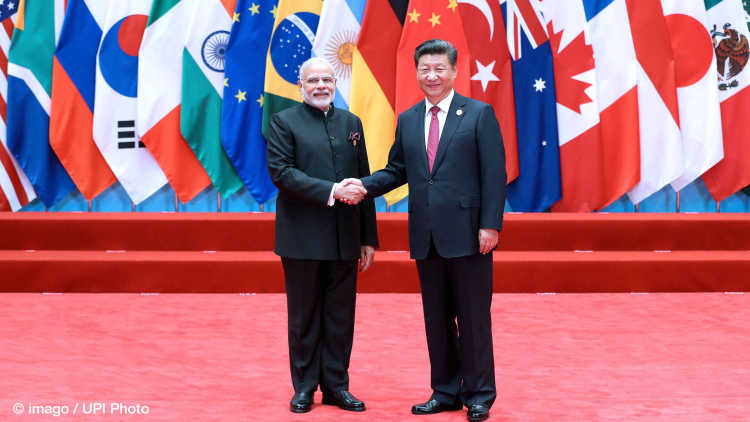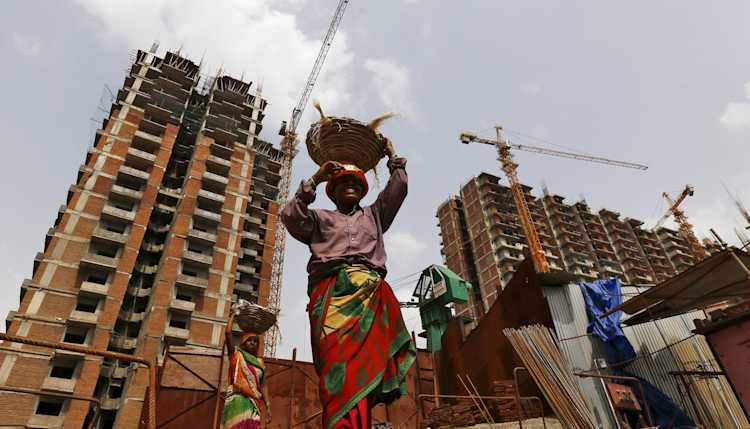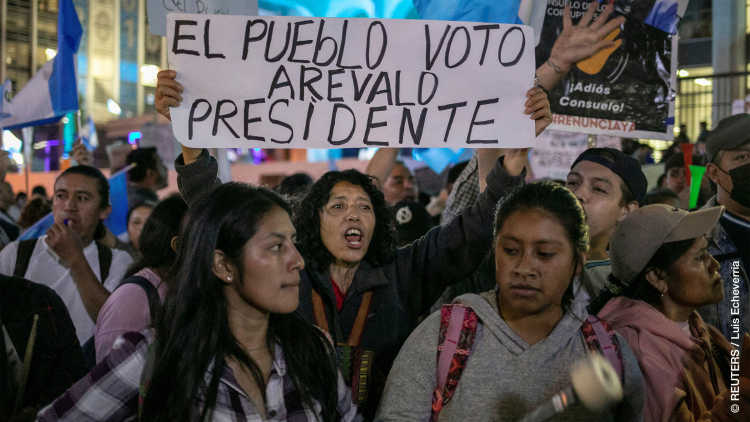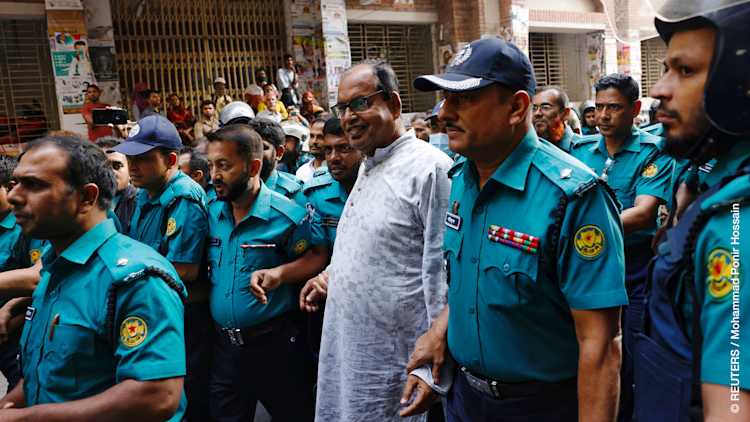- Startseite
- Publikationen
- GIGA Focus
- India after the 2024 Elections: Trends and Implications
GIGA Focus Asien
India after the 2024 Elections: Trends and Implications
Nummer 3 | 2024 | ISSN: 1862-359X

Prime Minister Narendra Modi seems to be in pole position to win India’s upcoming national elections. While their course will determine India’s democratic credentials, their outcome will define its role in addressing regional and global challenges. We present key factors that may shape Indian politics, governance, and its interaction with foreign powers in the coming years.
Internal politics: The past ten years have seen the rise of a powerful centralised government bolstered by the popularity of Prime Minister Modi. This has raised questions about executive accountability, challenged the federal character of India, and curtailed civil liberties. The election results may portend the reversal or consolidation of these trends.
International dynamics: Amid rising geopolitical competition in the Indo-Pacific, India will look to increase its engagement with regional minilaterals and a broad array of partners from the West and the Global South. Success will in part depend on whether it can maintain its attractiveness as a partner externally amid mounting majoritarianism domestically.
Trade and economics: To sustain resilient growth in the face of geoeconomic shocks, India will focus primarily on bilateral free trade agreements, expanding its integration in global supply chains, and bolstering its manufacturing sector.
Climate issues: Climate change has moved from the periphery to being an important, albeit not critical, electoral issue in 2024. How it influences India’s elections will significantly shape the global climate agenda.
Policy Implications
The erosion of democracy under Prime Minister Modi has caused deep concern abroad. The EU and Germany have fundamental and growing economic, environmental, and strategic interests in strong ties with India, independent of its democratic record. Yet, the very importance of India also requires an awareness of the risks involved in dealing with an ever less democratic country.
A Watershed Moment
From 19 April to 1 June 2024, about 969 million registered voters (10 per cent of the global population) will head to the polls in India. The national elections have been hailed as one “for the progress of the country” by the ruling party and a way to “save democracy and protect the constitution” by the opposition parties. Even as the opposition bloc – the Indian National Developmental Inclusive Alliance (INDIA) – gears up, many political observers say that the odds are in favour of the incumbent, the National Democratic Alliance (NDA) – a coalition government led by Prime Minister Narendra Modi, with his Bharatiya Janata Party (BJP) at the helm. We look at how the Modi regime has performed over its previous two terms, and what are likely to be major trends for the new (or continued) government.
Centralisation of Power
Since 2014, there has been a steady shift towards the centralisation of executive power sustained by the personality cult around Prime Minister Modi. An election verdict in favour of the ruling party for the third time in a row may entrench its ongoing extension of power. Three noteworthy factors in this regard are the Modi government’s capacity to push through its policies overriding the opposition, its alleged use of key government agencies to deter critical voices, and its increasing assertion of authority over state governments, straining India’s federal structure. While the Modi government has banked on the rhetoric of “good governance” to justify its proclivity for centralisation of political power, studies have shown that these factors have attenuated executive accountability mechanisms (Khaitan 2020).
Taking the first factor, the BJP-led government has exercised its numerical dominance in parliament to pass bills without much discussion. During the 2023 winter session, for example, 146 opposition party members representing almost 20 per cent of the strength of the lower house were suspended till the latter’s adjournment. During this time, crucial bills were pushed through by the ruling NDA, steamrolling the opposition. These included ones that replaced India’s existing criminal justice laws and a bill that gave the central government a greater say over the selection of the country’s election commissioners. Two new election commissioners were already appointed by a prime minister-led panel under this new law six weeks before the elections. A greater or lesser majority for the BJP in the coming national elections could conclusively determine the power of the legislature to offset the executive.
Second, raids as well as arrests of opposition party members by government investigative agencies such as the Enforcement Directorate (ED) and the Central Bureau of Investigation have increased. About 95 per cent of ED cases since 2014 have been against opposition leaders – a fourfold rise compared to similar cases under the previous regime (Tiwary 2024). Fourteen political parties approached the Supreme Court in March 2023 regarding the “misuse” of these agencies against opposition parties and civil society actors (Sharma 2023). For example, the 2024 national elections have been preceded by the news of the freezing of the bank accounts of the Indian National Congress (INC), the largest opposition party, and the arrests of a former and a sitting chief minister belonging to opposition parties. The charges against opposition figures range from corruption to tax evasion. The INC has parried these charges as attempts by the ruling party to hamper their operations before the elections. This has raised questions about a level playing field, as critical for free and fair elections.
Third, an unchallenged ruling party at the centre of power has consequences for centre–state relations. The BJP has touted “double-engine sarkar” – that is, the same party as the head of government at both the national and federal level – to be beneficial for the development of a state. The BJP has also pushed for “one nation, one election” (simultaneous elections of national and state assemblies), ostensibly to make polls more efficient and cost-effective. These are viewed by the opposition as attempts to weaken India’s federal structure (Chandrasekhar 2023). Certain actions have contributed to the trust deficit between the centre and non-BJP government-led states. These include actions that purportedly increase the central government’s interference in state affairs, such as passing three disputed farm bills overriding the opposition, demonstrating a “regional bias” in the devolution of funds for states, and appointing governors viewed as being pro-BJP in states led by non-BJP governments (Veeresha 2023). Such increased political centralisation puts to the test India’s cooperative federalism. While these factors speak of declining checks on power from other branches of the government and opposition parties, reports and surveys indicate a waning of civil society’s democratic rights.
Shrinking Civil Spaces
The Indian state has long had instruments at its disposal to restrict civic action in the name of security or development. These have been used by governments led by different political parties against journalists and civic actors to varying degrees. This targeting has intensified since 2014 as per various data-driven media and policy reports. In 2022, V-Dem downgraded India to an “electoral autocracy,” based on a decline in press freedom as well as political and civil liberties.
As the government has amended laws such as the Foreign Contribution Regulation Act (FCRA) and the Unlawful Activities (Prevention) Amendment Act (2019) (UAPA), it has become easier to target and restrict activists as well as both domestic and international civil society organisations (CSOs). Almost 17,000 CSOs, including Amnesty International, Greenpeace, and Oxfam, lost their licences to operate in the country between 2015 and 2022, more than four times the number who did so between 2011 and 2014. Grounds for cancellation were often compliance issues under the new FCRA regulations. Meanwhile, the UAPA made it easier for the government to brand certain individuals “terrorists,” making it almost impossible for the accused to make bail. UAPA cases rose from two in 2013 to 38 in 2021. The Finance Act (2019) also enhanced the powers of the ED: namely, to search and seize property without registering a complaint with a competent authority and to imprison suspects without conviction on the pretext of money laundering. ED cases rose from 112 between 2004 and 2014 to 2,974 between 2014 and 2022 (Mukherji and Zarhani 2023). However, the ED’s conviction rate was just 0.5 per cent regarding money-laundering cases through March 2022 (Mukherjee 2023).
India’s ranking in the World Press Freedom Index fell to 161 out of 180 countries worldwide in 2023 from 140 out of 180 in 2014. During the farmers’ protests in Delhi in 2020 and 2021, certain critical media outlets faced Twitter-account bans or income-tax raids, with some journalists accused of sedition. Other reputable media outlets have come under the control of business magnates closely aligned with the BJP. Most notably, in 2022, New Delhi Television Ltd. (NDTV), the network that pioneered independent news broadcasting in India, was acquired by Gautam Adani, a billionaire with allegedly close links to the ruling party. A 2023 survey of 206 journalists found that 80 per cent believed that the press covers the Modi government too favourably (Mukherji and Zarhani 2023).
A number of monitoring organisations and indexes, including V-Dem and Scholars at Risk, have found that academic freedom and institutional autonomy have declined in India in recent years. Universities have faced pressure to restrict work deemed “politically sensitive” by the government. Between 2014 and 2020, there were 54 incidents where events on campuses were cancelled due to pressure from organisations linked to right-wing groups, notably higher than the five such incidents recorded between 2010 and 2014. While there has been some pushback from civil society against these restrictions, a majoritarian mandate would further shrink the available space and scope for such contestation.
Shifts and Continuities in Foreign Policy
With a multipolar world in the making, India enjoys an international setting that may be more conducive to its ascendancy than at any time previously in its history as an independent state. Its internal market and growing population make it an attractive investment destination for Western businesses keen to diversify risk amid China’s increasing assertiveness. Intensifying United States–China rivalry has markedly raised India’s value as a security partner for the West. Modi and his key foreign policy personnel have leveraged India’s comfortable strategic position to their advantage. Yet, an emphasis on Hindu nationalism and an increasing personality cult around Modi also pose foreign policy risks that may play out forcefully during his third term, should it come to pass.
Modi has preserved India’s strategic autonomy, shying away from binding alliances. India has deepened its trade relations with Russia, while continuing to improve ties with the US. With highly visible state visits and vital defence agreements, India–US relations today are closer than ever. The Modi government has further developed its partnerships with France and Japan, especially on infrastructure and defence.
Regionally, Delhi has continued previous governments’ initiatives albeit under the new slogans of “Act East” and “Neighbourhood First.” Relations with Bangladesh have improved, as steps like the India–Bangladesh Land Boundary Agreement of 2015 have helped resolve the two countries’ border disputes, at least to some extent, amicably. Fearful of growing Chinese investments, India has also extended numerous lines of credit to neighbouring countries. Yet, key disagreements remain unresolved, from the sharing of river water to migration. Anti-Indian sentiment persists across South Asia, with its neighbours forging closer ties with Beijing to hedge against Indian predominance.
A visible change to India’s foreign policy under Modi is the absence of any meaningful attempts to resolve tensions with Pakistan. Relations have gone from bad to worse, including a limited airstrike on Pakistani soil ahead of India’s national elections in 2019. As a corollary, the South Asian Association for Regional Cooperation, also including Pakistan, is practically defunct. A looming conflict pertains to water-sharing with Pakistan following Indian plans for new hydropower projects on its western borders.
The Modi government is aware of its military and economic limitations vis-à-vis China, its powerful northern neighbour. Initial attempts at leader-level personal diplomacy did not produce closer ties. Although not provoked by India, tensions across the border have escalated repeatedly. As a result, India is investing heavily in security via new infrastructure and an increased military presence along the contested border. Prospects for a breakthrough in relations are dim, as illustrated by Chinese President Xi Jinping’s absence from the G20 summit held in New Delhi in September 2023.
Modi has intensified India’s ties with states in the Arabian Gulf and North Africa, from Egypt to Saudi Arabia. At the same time, Israel has become an important partner in defence procurement and other sectors, thus tacitly shedding India’s traditional concerns over the latter’s policies vis-à-vis Palestine. This exposes the difficulties with Indian claims to leadership of the Global South, a key message the country sought to convey throughout its G20 presidency in 2023. Although initially showing little interest in the Non-Aligned Movement that India helped establish, the Modi government today regards it a useful avenue to undergird its claim to leadership of the Global South and work towards the reform of established international institutions, the United Nations in particular. India also visibly appreciates the global trend towards more exclusive leader-level summits, like the G20, the Shanghai Cooperation Organization, the Quad (Quadrilateral Security Dialogue, maintained between Australia, India, Japan, and the US), and the now expanded BRICS+ grouping as well.
Modi’s consistent outreach to the Indian diaspora worldwide has been a noteworthy feature of his foreign policy. Addressing tens of thousands of people of Indian origin in Australia, the US, and elsewhere, Modi has effectively created a novel tool of foreign policy, often backed by enthusiastic supporters abroad. However, the stifling of dissent domestically has in the past few years clearly extended abroad, with the widespread self-censorship of intellectuals, journalists, and academics outside India. A repressive climate domestically affects India’s appeal as a partner in science and cultural exchange, potentially undermining its prospects as a vast soft power.
Meanwhile, stoking nationalist sentiment domestically may tarnish India’s image in the immediate neighbourhood and contribute to a more conflictive foreign policy going forwards. An early indication of this was the Indian blockade of landlocked Nepal in the aftermath of a devastating earthquake and the adoption of a new Nepalese Constitution in 2015, of which India disapproved. More recently, a diplomatic row with the Maldives following the election of Mohamed Muizzu as president in late 2023, an outspoken India critic, was fuelled by nationalist fervour in India, apparently with the approval of the latter’s government. Last September, Canadian Prime Minister Justin Trudeau alleged Indian agents were involved in the assassination of a Sikh separatist leader in his country. Weeks later, US officials stated they had thwarted another assassination attempt on their soil, also with links to India. Although unlikely to fundamentally alter US–India ties, both incidents call into question India’s ability to pragmatically separate domestic from international politics.
Towards a Proactive Defence Strategy
Under Modi, India’s outlook on national security has shifted from cautious to proactive. The 2014 “Doval Doctrine,” introduced by his national security advisor, presents a hawkish approach to national security that has heavily influenced India’s orientation on defence. Beijing and Islamabad strengthening their ties and Chinese forays into the Indian Ocean have brought the possibility of a multifront war to the fore. Alongside this, advancements in military technology have highlighted the need to develop the country’s armed forces based on an all-encompassing assessment of current and future needs, rather than on defeating specific potential adversaries.
In keeping with his strongman image, Modi has repeatedly expressed his commitment to making India militarily strong. To this end, his focus has been on transforming the armed forces to bolster capacity, increase tri-service integration, and – in a bid to reduce excessive reliance on imported defence platforms – to achieve self-reliance here. Such reform processes only took off during his second term, with the creation of the post of Chief of Defence Staff (above the Army, Navy and Air Force) in 2019 and the Department of Military Affairs within the Defence Ministry a year later. His government also introduced an integration plan to restructure the tri-services into three theatre commands, focused on Pakistan, China, and maritime operations in the Indian Ocean Region, respectively.
In terms of capacity, India has markedly increased its investments in new technology. The Galwan conflict in 2020 was a turning point, after which the military received emergency powers to issue defence contracts up to USD 36 million without time-consuming bureaucratic approval or tender processes. The 2024 defence budget further emphasised acquiring deep-tech capabilities through schemes like “Innovations for Defence Excellence” seeking to incentivise the emergence of startups in cutting-edge fields (like artificial intelligence, quantum computing, and nanotech).
However, India’s defence expenditure has seen meagre hikes, even declining as a percentage of gross domestic product since 2020. This will likely impact modernisation and procurement plans. Russia’s preoccupation with its prolonged war of aggression in Ukraine has also hindered its supplying of munitions to India. While existing deals will continue to run, Delhi is unlikely to sign any major new military ones with Russia, focusing instead on diversifying its weapons base by fostering indigenous manufacturing drawing on Western technology. Since 2020, the Modi government has released five “Positive Indigenisation Lists” indexing defence equipment that is on a phased import ban and to be procured locally instead. A restructuring of the Defence Research and Development Organisation (DRDO), India’s premier agency for R&D regarding military technology, is also under discussion. The aim is to streamline its functions to focus instead on high-end futuristic technologies and delegate a bigger role to the private sector going forwards. This could shift much of the DRDO’s decision-making to the Prime Minister’s Office, which would be directly involved in key projects in consequence.
Yet, challenges persist. Progress on defence reforms has been slow amid deep-rooted interservice rivalries and “preserving the status quo” mindsets. Those changes that have been made have also received mixed reviews. While supporters laud command-structure reforms for giving the military a greater voice in decision-making related to national security, critics view these interventions as an attempt to exploit inertia in the armed forces to further assert Modi’s dominance and gain political dividends. India still lacks a formal, comprehensive national-security strategy, resulting in an absence of clarity on long-term defence preparedness.
Despite some progress, India is far from Modi’s original goal of producing 70 per cent of military equipment locally by 2020. It remains the largest defence importer in the world. On big-ticket items like tanks and jets especially, Indian industries struggle to meet the qualitative requirements of the military. Finally, achieving Modi’s aim to double defence exports to USD 5 billion by 2024/2025 from USD 2.63 billion in 2023/2024 will require sustained investment in the defence-industry ecosystem – a strategic priority for the new government.
A Mixed Economic Report Card
India’s economic growth forecasts before elections paint an optimistic picture. Apart from the government’s Economic Survey (2022–23), data and statistics from the World Bank’s India Development Update (2023) and the International Monetary Fund’s annual Article IV consultation report on India (2023), cited below, place India in a better position than other emerging economies. Post-pandemic growth has been robust, driven by returning consumer confidence and considerably higher public and private investment. The rebound of private consumption was supported by the pent-up demand during lockdown, supporting the construction of new homes. Public investment has increased to 3.3 per cent of GDP, mainly focusing on upgrading roads and railways.
Under Modi, sectoral growth has been uneven: strong in services, moderate in manufacturing, yet disappointing in agriculture. The government and the Reserve Bank of India have successfully stemmed rising inflation by raising interest rates and deepening protectionist measures to safeguard the consumer. The public deficit has reduced to (a still unsustainable) 9 per cent of GDP, but the country is well on its way to further consolidation, helped by the recent boost in tax and remittances. Public expenditure has also gone to a large – albeit declining – extent into subsidies, salaries, defence spending, and social programmes. The financial system has gained in strength, non-performing assets fallen, while the financial buffers of private (less so of public) banks have been more than adequate. Lending to local companies has been boosted as a result.
For some time now, with no improvement witnessed under the Modi government, export growth has been somewhat subdued because of falling global demand. Imports have marginally declined, as induced by falling international oil and gas prices. The current-account deficit has climbed modestly to 1.1 per cent of GDP – remaining manageable because of greater capital inflows, turnaround in export growth, and increasing foreign exchange reserves. India’s debt-to-GDP ratio was at 81 per cent in 2022/23, denominated overwhelmingly in rupees (International Monetary Fund 2023). Notably, India’s foreign direct investment inflows (gross, net, and as percentage of GDP) have declined to their lowest levels since 2007/8.
Yet, challenges persist vis-à-vis India’s economic trajectory. Rapidly rising greenhouse gas emissions endanger national and global sustainability. For the incoming government, it will be vital to avoid an even greater carbon footprint by switching more aggressively to renewables and by selling energy at market prices, thus helping make distribution companies, dependent as they are on repeated bailouts, viable enterprises.
India’s economic development largely bypassed a take-off in low-skill, job-rich sectors as it shifted from a mainly agrarian to a services-led economy. India will need to create between 145 and 330 million jobs by 2050 to absorb its young and growing workforce. Most new jobs have been created in the low-productivity agriculture and informal sectors. The female labour force participation rate remains low, with women’s formal employment at around 10 per cent at present.
While it is the fifth-largest economy worldwide, India is not a global leader in productivity terms. In agriculture, it is far below the frontrunner (the US) at 2.3 per cent; in productive services (business, health, information), it is only at 20 per cent. This is partly the result of too many firms remaining in the informal sector (to avoid labour and other regulations), fragmentation and overmanning in agriculture, and high import and foreign-investment barriers limiting participation in global value chains. The manufacturing sector is catching up faster, but offers relatively few jobs on account of being capital-intensive.
Social expenditure has increased by around twofold over the last decade in nominal terms, although mostly on healthcare. This has resulted in a massive improvement of certain indicators (e.g. infant and maternal mortality rates). In education, extremely poor learning outcomes in primary and secondary schools are not budging. The lack of broad-based vocational education is slowly improving. However, India lags behind on developing the skilled workforce needed for industry.
Welcome labour reforms have been enacted, but implemented only in some federal states. Agricultural reforms, essential to modernising the sector and adapting to climate change, remain pending. Privatisation efforts, while announced perpetually, have been limited, with the exception of Air India. The trade regime, less strict now, is plagued by higher import tariffs than in comparable economies as well as frequent anti-dumping actions. Focus on concluding new free trade agreements (FTAs) suffers from the participation of only minor partners (Australia, United Arab Emirates) while related negotiations with the heavyweights (China, European Union, US) drag on or have been abandoned altogether.
Despite the government’s statements to the contrary, India’s recent track record on economic multilateralism is poor. This is exemplified by its last-minute withdrawal from the Regional Comprehensive Economic Partnership, the drawn-out negotiations on an EU–India agreement, and the blocking of the latest World Trade Organization negotiating round’s successful completion. India has instead focused on pursuing bilateral treaties over genuine multilateral efforts.
A Climate Change Leader?
As the world’s third-largest emitter of CO2, India plays a pivotal role in contemporary climate politics. Despite its rising yet still relatively low per capita emissions compared to other major emitters (2022: 2 tonnes in India versus US (close to 15), China (8), and Germany (over 8)), its sheer size makes it a key player in sustainability efforts. Climate change has been high on Modi’s global agenda since taking office. There is now growing awareness of its ramifications due to India’s vulnerability to extreme-weather events, the links between pollution and climate change, energy security, and the potential for global leadership in the climate regime. The increased sensitivity to these issues is evidenced by the Indian Supreme Court’s landmark judgement recognising freedom from the adverse effects of climate change to be a fundamental right of citizens.
While climate change may not be a primary electoral issue, its impacts – including the flash floods and droughts that have come to plague India in recent years – are nevertheless likely to resonate with voters as an existential threat to their livelihoods. Similarly, discussions on pollution and the striving for greater energy security, especially through the expansion of renewables, find sway with voters. However, it is unlikely that the upcoming elections will induce any significant changes in India’s position hereon. Even under a new government, continuity is likely to prevail when it comes to the progressive aspects of environmental and climate politics.
The Modi government has a mixed record in this regard. Policies like the “Forest Conservation Bill” of 2023 enable the diverting of forest land to private developers without the consent of forest-dwelling communities. They have been characterised as a “disaster for the country’s forests and the forest-dependent people” by parliamentarians (Viswam 2023). In striving to build infrastructure, the government has been criticised for prioritising business interests over climate and other social concerns, leading to considerable environmental harm and ultimately countering efforts to mitigate climate change (Majumder 2024). A 2023 Utility Bidder report found that India was recording the second-highest deforestation rate worldwide, losing 668,400 hectares of forest land between 2015 and 2020. Moreover, its industries often violate emission standards with impunity, and effective measures to reduce air pollution are lacking.
Both nationally and internationally, the Modi government has been lauded for its aggressive expansion of renewable energies. While the share of coal in installed generation capacity is still at 49.1 per cent (IEA n.d.), that of solar and wind especially is growing rapidly. India has more than tripled its capacity, from 35 gigawatts in 2014 to 125 GW as of 2023, which is just under 40 per cent of total installed electricity capacity yet far from the promise of 500 GW by 2030 (CEA n.d.). Moreover, the 2024–2025 interim budget includes some crucial measures – like a scheme to subsidise solar panels for homes – to push green-energy expansion and help reach India’s net-zero promise by 2070. Yet, this raises the topic of potentially contradictory trends, as the country is also at the forefront of an expansion, or at least consolidation, of global coal consumption and imports. Both renewables and fossil fuels have grown substantially – a development observed with increased concern by developed and developing countries alike.
This may become a problem for the Modi government’s expansive ambitions of assuming a leadership role in the Global South, especially in the realm of climate change. India has indeed become an important voice here, shaping a Southern narrative on climate action. We can expect related policies to continue to be aggressively pursued on the global stage, despite critics saying that India’s level of commitment to emission reductions is not ambitious enough for the Paris Agreement. While this view will be rejected by referring to India’s historically miniscule emissions, it is unlikely that such counterarguments will long resonate with the rest of the world. This may become a problem for Modi, as leadership on climate change is crucial to his envisioned legacy.
A Cautious Outlook for India–EU Relations
As one of the world’s fastest-growing major economies, India’s stature on the global stage is rising. The outcome of the forthcoming elections will have important consequences not only for the country and its global standing but also the international community at large. India, under the current regime, has been part of a global trend of democratic backsliding. According to a pre-poll national survey, inflation and unemployment, rather than declining civil liberties, are pressing concerns for voters, without causing a significant dent in Modi’s popularity (The Hindu 2024). The increasing nationalistic rhetoric that aggravates religious and ethnic fault lines has aided the BJP’s rise to power and may persist. As EU–India relations are built on shared values, this may become a sticking point in their interactions, including on FTA negotiations – which the EU insists must be based on human rights.
Regardless of the challenges facing the country, India’s rise – both economic and geopolitical – seems inevitable. There will be more opportunities for military, security, climate, energy, and technology cooperation. For example, the EU and India are branching out into emergent tech areas including AI. In defence, India’s desire for private players to play a bigger role, and strategically diversifying away from Russian military imports, will open new doors for joint projects here. There is huge scope for weapons deals and exports from EU members like France and Germany, alongside increased joint exercises. However, even as India looks to diversify from Russia, this may be a slow process. India will likely be unwilling to revise its position on the Ukraine War as part of its broader desire to deter Russia from becoming a junior partner to China. Should the war continue to persist, new free-trade frameworks between India and Russia could hinder greater strategic convergence with the EU.
On climate change particularly, engaging with India on a level playing field will be crucial. The urgency of the problem mandates that the EU must find mutual points of interest that can help return us to a safe planetary trajectory. Theoretically, at least, the tool of a “just energy transition” could be useful here.
Fußnoten
Literatur
CEA, Ministry of Power, Government of India (n.d.), National Power Portal, accessed 21 March 2024.
Chandrasekhar, C.P. (2023), How the Modi Government is Dismantling India’s Federalism, Politically and Fiscally, in: Frontline, 21 September, accessed 17 March 2024.
IEA (n.d.), India—Countries & Regions, accessed 21 March 2024.
International Monetary Fund (2023), IMF Executive Board Concludes 2023 Article IV Consultation with India, 18 December, accessed 12 March 2024.
Khaitan, Tarunabh (2020), Killing a Constitution with a Thousand Cuts: Executive Aggrandisement and Party-State Fusion, in: Law & Ethics of Human Rights, 14, 1, 49–95, accessed 17 March 2024.
Majumder, Raktim (2024), Concrete Ambitions: The Environmental and Livelihood Toll of BJP’s Decade-Long Infrastructure Drive, in: The Wire, accessed 21 March 2024.
Mukherjee, Vasudha (2023), Decoding the ED: Understanding Its History, Powers, and Criticisms, in: Business Standard, 22 November, accessed 7 February 2023.
Mukherji, Rahul, and Seyed Hossein Zarhani (2023), India’s Democracy: The Competitive Authoritarian Propensity?, in: Pacific Affairs, 96, 4, 747–768, accessed 17 March 2024.
Sharma, Padmakshi (2023), 95% of Political Leaders Investigated by CBI & ED are Opposition Leaders: Non-BJP Parties Tell Supreme Court, in: Live Law, 24 March, accessed 7 February 2024.
The Hindu (2024), Lokniti-CSDS 2024 Pre-Poll Survey | Jobs, Inflation Key Issues in 2024 Lok Sabha Elections, 11 April, accessed 12 April 2024.
Tiwary, Deeptiman (2024), Kejriwal Arrest: 95% of ED Cases since BJP Came to Power in 2014 against Opposition Leaders, in: The Indian Express, 22 March, accessed 23 March 2023.
Veeresha, Nayakara (2023), In the Era of Centralisation, in: Deccan Herald, 5 March, accessed 18 March 2024.
Viswam, Binoy (2023), The Future Will Not Forgive the Government, in: The Hindu, 17 August, accessed 8 April 2024.
Redaktion GIGA Focus Asien
Lektorat GIGA Focus Asien
Regionalinstitute
Forschungsschwerpunkte
Wie man diesen Artikel zitiert
Duggal, Mahima, Sangeeta Mahapatra, Johannes Plagemann, Adhiraaj Anand, Joachim Betz, und Miriam Prys-Hansen (2024), India after the 2024 Elections: Trends and Implications, GIGA Focus Asien, 3, Hamburg: German Institute for Global and Area Studies (GIGA), https://doi.org/10.57671/gfas-24032
Impressum
Der GIGA Focus ist eine Open-Access-Publikation. Sie kann kostenfrei im Internet gelesen und heruntergeladen werden unter www.giga-hamburg.de/de/publikationen/giga-focus und darf gemäß den Bedingungen der Creative-Commons-Lizenz Attribution-No Derivative Works 3.0 frei vervielfältigt, verbreitet und öffentlich zugänglich gemacht werden. Dies umfasst insbesondere: korrekte Angabe der Erstveröffentlichung als GIGA Focus, keine Bearbeitung oder Kürzung.
Das German Institute for Global and Area Studies (GIGA) – Leibniz-Institut für Globale und Regionale Studien in Hamburg gibt Focus-Reihen zu Afrika, Asien, Lateinamerika, Nahost und zu globalen Fragen heraus. Der GIGA Focus wird vom GIGA redaktionell gestaltet. Die vertretenen Auffassungen stellen die der Autorinnen und Autoren und nicht unbedingt die des Instituts dar. Die Verfassenden sind für den Inhalt ihrer Beiträge verantwortlich. Irrtümer und Auslassungen bleiben vorbehalten. Das GIGA und die Autorinnen und Autoren haften nicht für Richtigkeit und Vollständigkeit oder für Konsequenzen, die sich aus der Nutzung der bereitgestellten Informationen ergeben.








































